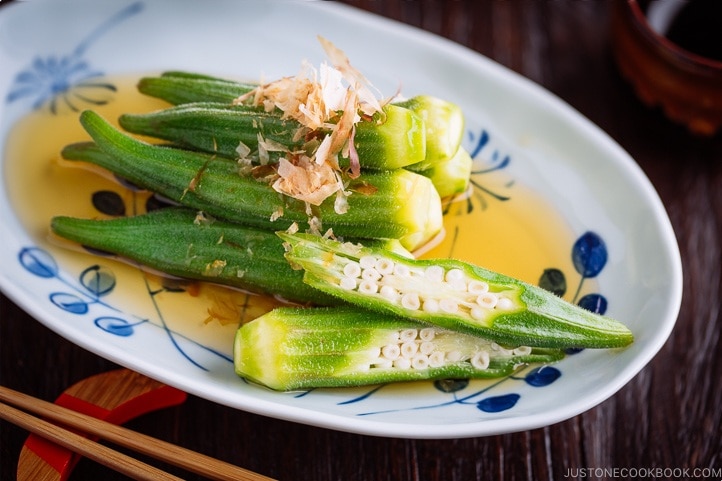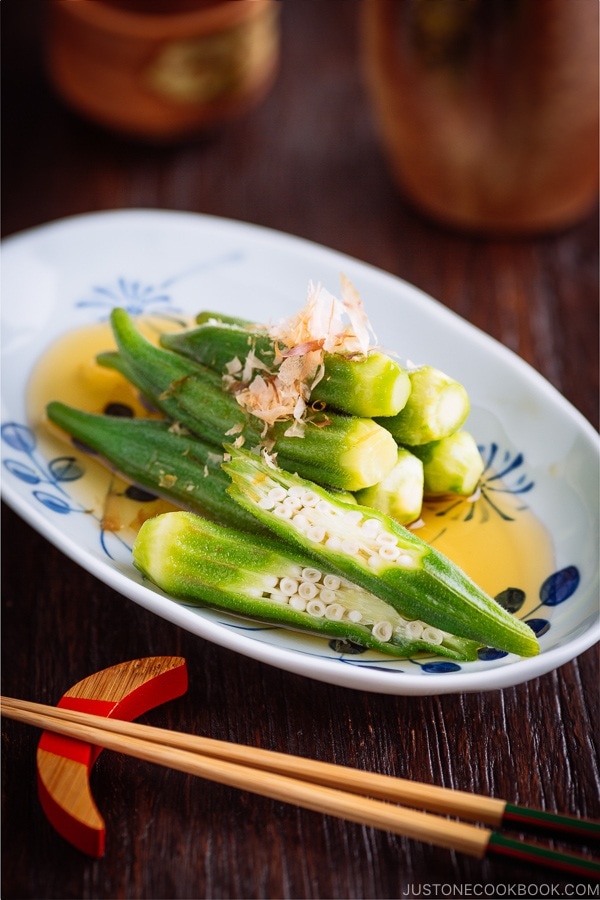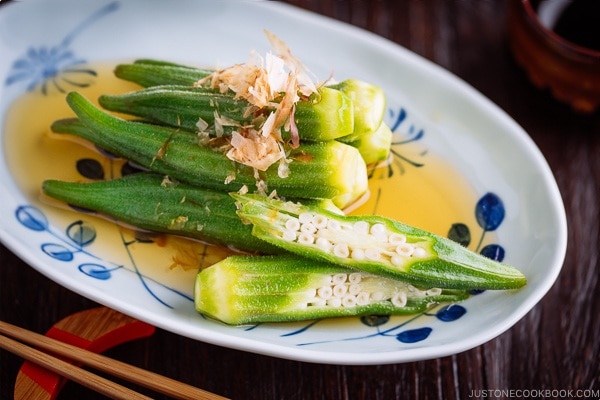
Okra Ohitashi is a simple, light, and flavorful Japanese side dish of blanched okras in a soy sauce-based marinade.

One of the easiest side dishes you can make to accompany your Japanese meal is Ohitashi. Today I’m sharing Okra Ohitashi (オクラのおひたし) or Japanese Okra Salad. This simple vegetable recipe is super handy when you are in need of something refreshing and wholesome to balance the dinner.
What is Ohitashi?
Ohitashi (おひたし) is a Japanese cooking method, meaning “soaking”, which is turned into a dish name. Yes, it’s kind of like Teriyaki, a cooking method (applying glossy sauce + grill) that has been doubled as a dish name.
For Ohitashi dishes, fresh ingredients are typically blanched quickly, and then soaked in a dashi-infused soy sauce based marinade for several hours. The marinade has umami from dashi (katsuobushi & kombu dashi or vegetarian/vegan dashi), savory taste from soy sauce, and a tinge of sweetness from mirin.
If you’re looking for an interesting side dish for your Japanese style Ichiju Sansai (1 soup 3 dishes) meal, this Okra Ohitashi will work to round things up for you.

3 Tips to Make Delicious Okra Ohitashi
1. Do not overcook the vegetables
Set a timer or pay attention to the doneness of the okra. You do not want to overcook the vegetables and as they can easily lose texture and turn mushy.
2. Use ice bath to stop cooking immediately
It might look like an extra work to prepare iced water, but it’s the most efficient way to stop the cooking immediately. Ice bath helps prevent the okra from turning mushy and revive the color. However, make sure to remove the okra (or other vegetables) from water as soon as they are cool. You don’t want them to be watery or lose the nutrients.
3. Squeeze water out well
You don’t want to dilute the sauce with excess moisture coming from the vegetables. Therefore, squeeze tightly to remove water before you soak the okra or any other vegetables you use in the ohitashi marinade.

Variations of Ohitashi You Can Make besides Japanese Okra Salad
With its crisp-tender and unique viscous texture, okra can make an appealing side than the usual boring vegetables. It is also a good source of minerals, vitamins, and fiber too! When they are in season, I like to snatch them up quick and make ohitashi right away.
While I enjoy okra, I know not everyone has the same liking for this finger-shaped vegetable. So if you are not a big fan, you can certainly use other vegetables for this ohitashi recipe. Here are some of the common ingredients used for ohitashi dishes in Japan.
- Asparagus
- Bean sprouts
- Bell pepper
- Bitter melon (Goya)
- Celery
- Eggplant (a deep-fried version)
- Komatsuna
- Komatsuna & Aburaage
- Nanohaya (rapeseed flower)
- Napa cabbage
- Shungiku
- Shungiku & Aburaage
- Spinach (recipe here)
With just a handful of ingredients, the ohitashi technique is a fool-proof way to get more vegetables to the plate. Like this easy Okra Ohitashi, you will need only a few minutes to prepare your vegetable ahead of time and enjoy on a daily basis.

Don’t want to miss a recipe? Sign up for the FREE Just One Cookbook newsletter delivered to your inbox! And stay in touch on Facebook, Google+, Pinterest, and Instagram for all the latest updates.
Okura Ohitashi (Japanese Okra Salad)

Okra Ohitashi is a simple, light, and flavorful Japanese side dish of blanched okras in a soy sauce-based marinade. Prepare it ahead of time, so you can serve this salad instantly for dinner.
- 10 Okras
- ½ tsp kosher salt
- Katsuobushi (dried bonito flakes) ((for sprinkling, omit for vegetarian))
Marinade
- 1 cup dashi ((240 ml) (use Kombu dashi for vegetarian; See Notes))
- 2 Tbsp usukuchi soy sauce ((= light color soy sauce – See Notes; You can use regular soy sauce))
- 2 Tbsp mirin
- Gather all the ingredients.

-
Cut off the tail end of okras. Peel off the hard part around okra end shown in the picture below.

-
They should look like this. Tip: If you cut the end completely, water gets inside.

-
Bring enough water to a boil. Sprinkle kosher salt over okras and rub gently on the cutting board. Tip: This brings out the bright color of any green vegetables (such as cucumbers) and removes the bitter taste.

-
Once the water has come to a boil, put in the okras (without removing the salt) in the boiling water and blanch for 1-2 minutes.

-
Drain and let cool the okras in iced water. As soon as they are cool, remove from the water and squeeze gently to remove excess water. Set aside.

- In a small saucepan, add mirin and let the alcohol evaporate for 1-2 minutes.

- When there is no more alcohol smell, add dashi and soy sauce. Once it boils, turn off the heat and set aside.

-
Transfer the okras to a shallow glass baking dish. Pour the marinade into the dish while the marinade is still warm. Let steep at room temperature for at least 1-2 hours before serving.

To Serve
-
Plate okras on a serving dish, drizzle some marinade over the okras, and sprinkle katsuobushi. You can serve it at room temperature or chilled. Enjoy it within 2 days.

Dashi: Use kombu dashi for vegetarian/vegan. Here are 3 ways to make dashi. I usually make Awase Dashi (kombu & katsuobushi dashi).
Usukuchi (Light Color) Soy Sauce: Use this soy sauce when you want to keep the broth/sauce color lighter in color. Regular soy sauce can make the broth/sauce too dark in some dishes.
Recipe by Namiko Chen of Just One Cookbook. All images and content on this site are copyright protected. Please do not use my images without my permission. If you’d like to share this recipe on your site, please re-write the recipe and link to this post as the original source. Thank you.